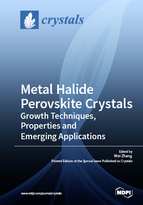Metal Halide Perovskite Crystals: Growth Techniques, Properties and Emerging Applications
A special issue of Crystals (ISSN 2073-4352). This special issue belongs to the section "Inorganic Crystalline Materials".
Deadline for manuscript submissions: closed (31 March 2018) | Viewed by 123388
Special Issue Editor
Special Issue Information
Dear Colleagues,
Metal halide perovskites have emerged as a rising star among various semiconductor materials in the past few years owing to their low cost, solution processability and fascinating combination of material properties, including tunable bandgap, high absorption coefficient, broad absorption spectrum, high charge carrier mobility and long charge diffusion length, which enable a broad range of photovoltaic and optoelectronic applications. Accompanied by the success in photovoltaic community that has witnessed a certified power conversion efficiency of 22.1% through a few years’ efforts, the rapid advancement is also achieved in the areas of light-emitting diodes, lasers, photodetectors, and solar-to-fuel energy conversion devices. Beyond the dominant format of polycrystalline perovskite thin films for solar cell applications, recent progress in metal halide perovskite crystals, ranging from nanocrystals, nanowires to macroscopic single-crystals, has spurred paramount scientific and industrial interests. Great research efforts have endeavored to develop new techniques for crystal growth, investigate the physical and chemical properties of the materials and explore their emerging applications. The perovskite single crystals, for instance, provide an excellent platform to characterize a range of materials’ properties that could not be achieved by studying polycrystalline thin films. Understanding the mechanism of the crystal growth provides insights for the better control of polycrystalline thin film quality in terms of crystal orientation and defect density, the key facts that restrict the solar cell performance. Perovskite nanocrystals and nanowires exhibit superior luminescent performance than their thin film counterparts, enabling potential applications like large area display. These exciting achievements call for a rationalization of the different forms of perovskite semiconductors beyond the widely used polycrystalline thin films. In the current Special Issue: “Metal Halide Perovskite Crystals: Growth Techniques, Properties and Emerging Applications”, we aim to provide a forum for the discussion and presentation of recent advances in the fields of research related to metal halide perovskite crystals. The potential topics of interest could be, but are not limited to:
-
Growth techniques of metal halide perovskite single crystals, nanowire and nanocystals
-
Mechanism of crystal growth
-
Characterization of metal halide perovskite crystals
-
Emerging applications of metal halide perovskite crystals
Scientists working in this broad field, and many other aspects related to perovskite crystals but not summarized here, are invited to present their work in this Special Issue. Full papers, communications, and reviews are all welcome.
Dr. Wei Zhang
Guest Editor
Manuscript Submission Information
Manuscripts should be submitted online at www.mdpi.com by registering and logging in to this website. Once you are registered, click here to go to the submission form. Manuscripts can be submitted until the deadline. All submissions that pass pre-check are peer-reviewed. Accepted papers will be published continuously in the journal (as soon as accepted) and will be listed together on the special issue website. Research articles, review articles as well as short communications are invited. For planned papers, a title and short abstract (about 100 words) can be sent to the Editorial Office for announcement on this website.
Submitted manuscripts should not have been published previously, nor be under consideration for publication elsewhere (except conference proceedings papers). All manuscripts are thoroughly refereed through a single-blind peer-review process. A guide for authors and other relevant information for submission of manuscripts is available on the Instructions for Authors page. Crystals is an international peer-reviewed open access monthly journal published by MDPI.
Please visit the Instructions for Authors page before submitting a manuscript. The Article Processing Charge (APC) for publication in this open access journal is 2600 CHF (Swiss Francs). Submitted papers should be well formatted and use good English. Authors may use MDPI's English editing service prior to publication or during author revisions.
Keywords
-
Metal halide perovskites
-
Single crystals, nanocrystals, nanowires, nanorods
-
Semiconductors
-
Photovoltaics, light-emitting diodes, lasers, photodetectors, optical and optoelectronic devices






